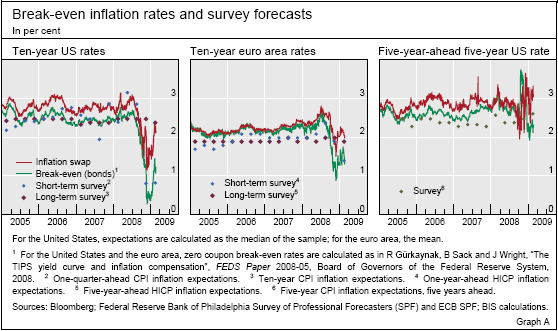Disentangling the drivers of recent shifts in break-even inflation rates
(Extract from pages 10-11 of BIS Quarterly Review, March 2009)
In recent months, break-even inflation rates, ie the difference between yields on nominal and real bonds, have been abnormally volatile, falling to unprecedentedly low levels before recovering somewhat in early 2009. The US 10-year break-even rate, for example, dropped to almost zero in late 2008 after having remained relatively stable at around 2.5% over the past several years (Graph A, left-hand panel). A similar pattern, albeit less pronounced, has been seen in euro area break-even rates (Graph A, centre panel).
A natural question to ask is: to what degree should these recent fluctuations be viewed as representing actual changes in expected inflation? Break-even inflation rates have long been used as an indicator of the markets' inflation expectations over the horizon of the bonds. Of course, during the financial crisis, the huge price swings in many markets, including those for nominal and index-linked bonds, have partly reflected "non-fundamental" factors. All in all, while falling inflation expectations are likely to have contributed to the drop in break-even rates, a substantial part of the decline was probably due to other factors, including liquidity and "market technicals".
Generally speaking, break-even rates can be thought of as consisting of four major components: (i) expected inflation; (ii) inflation risk premia; (iii) liquidity premia; and (iv) "technical" market factors.1 The relative importance of these components may vary over time as conditions in the economy and in financial markets change.
One way to assess the role of the first component is to look at other indicators of inflation expectations, such as survey data. According to the Survey of Professional Forecasters (SPF) conducted by the Federal Reserve Bank of Philadelphia, one-quarter-ahead expectations of US inflation fell from 2.9% in Q3 2008 to 0.8% in Q1 2009, but 10-year inflation expectations dipped only 0.1%, to 2.5%. Similarly, even though euro area short-term inflation expectations dropped significantly in recent months, the ECB's SPF also reported a drop of only 0.1% in long-term (five-year- ahead) inflation expectations, to 1.9%, between Q3 2008 and Q1 2009. This pattern suggests that average inflation expectations for the next few years have remained stable despite rapidly falling near-term expectations. However, some have questioned the plausibility of continued stable average inflation expectations over long horizons in view of the very large shocks that have hit the economy recently.
As regards the inflation risk premium, recent estimates suggest that this component has tended to be relatively small and fairly stable.2 If so, it is unlikely that the inflation premium has been responsible for a major part of the observed changes in break-even inflation rates. Nevertheless, some estimates suggest that inflation risk premia are positively correlated with inflation, implying that the recent decline in inflation could have brought about a lower inflation premium in line with falling break-even rates. Yet it seems intuitively reasonable to assume that the inflation risk premium may have increased, given higher inflation volatility and uncertainty about the possible effects on prices of recent monetary policy actions.
Liquidity premia, broadly defined, do seem likely to have played a large role in break-even developments. Strong flight-to-liquidity flows during the market turmoil led to soaring demand for nominal government bonds, probably inducing a negative premium in this segment. In other words, nominal yields were pushed to extremely low levels by this effect, which in turn led to strong downward pressure on break-even rates. In addition, because markets for index-linked bonds are substantially less liquid than those for nominal bonds, there is a higher risk that investors in indexlinked bond markets will encounter problems when quickly trying to exit positions at prevailing market prices. In normal times, this is typically seen as generating a relatively small liquidity premium on index-linked bonds. That type of premium probably increased considerably as liquidity risk rose, and aversion to such risk grew when the crisis deepened in the second half of 2008. This, in turn, would have increased the yield on real bonds relative to that on nominal bonds, hence adding to the downward pressure on break-even rates.
Linked to these liquidity effects, and to some extent indistinguishable from them, are technical market factors, which also appear to have been important drivers of break-even rates recently. Such factors include sell-side pressures from leveraged investors that were forced to unwind inflation-linked bond positions in adverse market conditions, which in turn resulted in rising real yields and hence falling break-even rates.3
Evidence from inflation swap markets can shed some light on the importance of these effects. An inflation swap is a derivative instrument that is similar to a regular interest rate swap. However, instead of exchanging a fixed payment for a variable payment linked to a short-term interest rate, the inflation swap links the variable payment to a measure of inflation, typically the accrued inflation over the life of the swap. The fixed leg of the inflation swap therefore provides a direct break-even inflation "price", which is unaffected by any differential liquidity conditions in nominal and real bond markets or by flight-to-liquidity flows.4
While the difference between 10-year inflation swap prices and corresponding bond break-even rates had remained stable in the past few years, the spread widened significantly towards the end of 2008 (Graph A, left-hand and centre panels). This suggests that the aforementioned liquidity and technical effects have played a significant role in bond market break-even rates. Nevertheless, inflation swap rates also declined notably in late 2008, a move consistent with expectations of lower inflation but probably also due to hedging of break-even positions in bond markets. Some of the declines in break-even rates were reversed in early 2009, possibly as a result of investors stepping in to take advantage of what was perceived as overly depressed break-even inflation levels.
Finally, a look at distant forward break-even inflation rates can be informative. For example, the five-year forward rate five years ahead is often seen as providing a cleaner indication of long-horizon inflation expectations than, say, a 10-year break-even rate because it should, at least in principle, be unaffected by near-term inflation expectations. Such forward break-even rates have become much more volatile in recent months, but there has been no clear shift in their overall level (Graph A, right-hand panel). The absence of such a shift would suggest that longer-term inflation expectations have remained broadly stable, which is in line with the view that the credibility of
central banks with respect to their commitment to price stability has not been eroded despite the recent rapid lowering of policy rates.
1 Other phenomena can affect break-even rates, including inflation seasonality and "carry" effects. Inflation seasonality effects refer to known seasonal fluctuations in consumer prices affecting prices on bonds linked to consumer price indices that are not seasonally adjusted. Carry effects have to do with persistent changes in consumer prices, such as those due to oil price movements, which are known to affect inflation today, whereas indexlinked bonds are linked to an index of prices several months old. However, these effects tend to be important mainly for short maturities, say up to a couple of years.
2 See P Hördahl, "The inflation risk premium in the term structure of interest rates", BIS Quarterly Review, September 2008, pp 23-38, and references therein.
3 Another such technical factor is the value of the embedded deflation floor, which for many index-linked bonds has increased recently, in particular for newly issued bonds that are close to the floor. Increased deflation floor values imply higher prices for those index-linked bonds that are affected, meaning lower real rates and hence higher break-even rates. This last effect would therefore not explain the recently observed fall in break-even rates. In addition, in our calculations of zero coupon real rates and break-even inflation rates, we do not include any recently issued real bonds. It is therefore likely that the deflation floor has played a minor role in our break-even inflation data.
4 Of course, this is not to say that inflation swaps are unaffected by any "technical" market factors, such as hedging effects. In addition, inflation swap markets are typically less liquid than bond markets.


